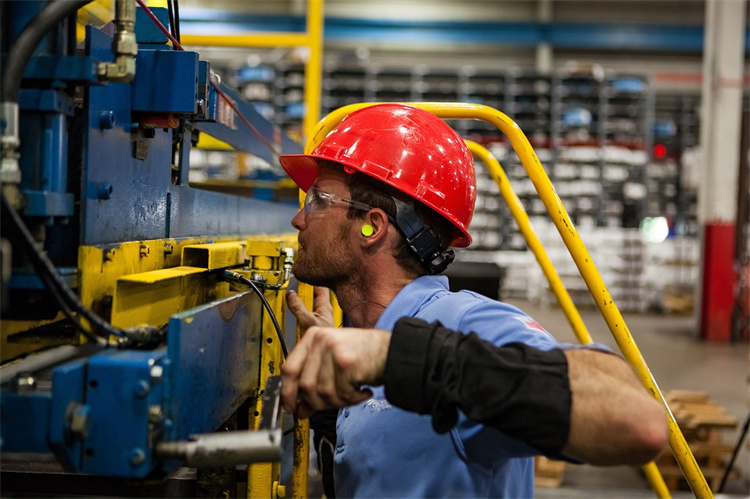Catalyzed by Intelligent Supply Chain Progress: Chinese Manufacturing's Journey to Brand Independence

Chinese manufacturing has evolved into a global powerhouse, ranking as the world's largest manufacturing country for 13 consecutive years as of 2022. The sector employs nearly 100 million people and contributes significantly to the Chinese economy. The progress in intelligent supply chain technologies has been instrumental in this transformation. These advancements facilitate real-time monitoring, efficient resource utilization, and precise business decision-making. The journey towards brand independence in Chinese manufacturing is significantly catalyzed by advancements in intelligent supply chain progress. This shift allows manufacturers to reduce reliance on foreign brands and enhance their global competitiveness.
Historical Context of Chinese Manufacturing
Early Stages of Manufacturing in China
Pre-reform Era
China's manufacturing industry before 1980 played a minor role on the global stage. The country had a manufacturing output similar to Italy. The focus remained on basic production with limited technological advancement. Factories operated under state control, leading to inefficiencies and low productivity.
Post-reform Economic Policies
The landscape changed dramatically after 1980. Economic reforms introduced by Deng Xiaoping transformed China's manufacturing capabilities. These policies encouraged foreign investment and privatization. Special Economic Zones (SEZs) like Shenzhen became hubs of industrial activity. The GDP soared, reaching 193,885 CNY HML by June 2021. This period marked the beginning of China's journey toward becoming a manufacturing superpower.
Rise as the 'World's Factory'
Factors Contributing to Manufacturing Boom
Several factors contributed to China's manufacturing boom. The availability of a large, low-cost labor force attracted global companies. Infrastructure development, including ports and railways, facilitated efficient logistics. Government incentives and subsidies further boosted industrial growth. Technological adoption played a crucial role in enhancing production efficiency.
Dependence on Foreign Brands
Despite the manufacturing boom, China relied heavily on foreign brands. Many factories operated as Original Equipment Manufacturers (OEMs), producing goods for international companies. This dependence limited the development of indigenous brands. The focus remained on high-volume production rather than innovation and brand building.
Intelligent Supply Chain Progress

Key Technological Innovations
Automation and Robotics
Automation and robotics have revolutionized Chinese manufacturing. Factories now use robots for tasks that require precision and speed. This technology reduces human error and increases production efficiency. For example, electrical car production in China has seen significant advancements. Companies like Volvo and BMW assemble vehicles using automated systems. These innovations cut costs and enhance autonomy.
Internet of Things (IoT)
The Internet of Things (IoT) connects devices and systems within the supply chain. Sensors and smart devices collect real-time data. This data helps manufacturers monitor and optimize operations. IoT enables predictive maintenance, reducing downtime. Factories can track inventory levels and manage resources more efficiently. The integration of IoT has made supply chains more resilient and responsive.
Artificial Intelligence (AI) and Machine Learning
Artificial Intelligence (AI) and Machine Learning (ML) play crucial roles in intelligent supply chain progress. AI algorithms analyze vast amounts of data to make informed decisions. Machine learning models predict demand and optimize inventory management. These technologies improve forecasting accuracy and reduce waste. AI-driven systems also enhance quality control by identifying defects early in the production process.
Implementation in Chinese Manufacturing
Case Studies of Leading Companies
Leading companies in China have successfully implemented intelligent supply chain technologies. Foxconn Technology Group uses advanced automation and AI in its factories. The company's supply chain management platform, JUSDA, integrates big data and IoT. This platform provides real-time visibility and collaboration across the supply chain. Another example is Huawei, which employs AI and ML to optimize its logistics and production processes. These case studies demonstrate the tangible benefits of intelligent supply chain progress.
Government Policies and Support
The Chinese government has played a pivotal role in promoting intelligent supply chain progress. Policies under the Made in China 2025 initiative focus on industrial upgrading. The government provides incentives for adopting advanced technologies. Special Economic Zones (SEZs) offer tax breaks and subsidies to attract high-tech industries. These policies encourage innovation and technological adoption in manufacturing. Government support has been instrumental in transforming China's supply chain landscape.
JUSDA's Role in Intelligent Supply Chain Progress
JusLink Platform and Real-time Collaboration
Features and Benefits
JUSDA's JusLink Platform revolutionizes supply chain management. The platform integrates modern technologies like the Internet of Things (IoT), cloud computing, and big data. These technologies break down isolated silos in supply chains. Enterprises can share information seamlessly across the entire chain.
The platform offers several key features:
Real-time Monitoring: JusLink enables real-time tracking of goods and materials. This feature reduces delays and improves efficiency.
Data Analytics: The platform uses big data to analyze supply chain performance. Companies can make informed decisions based on these insights.
Collaboration Tools: JusLink facilitates collaboration between suppliers, manufacturers, and customers. This enhances communication and reduces misunderstandings.
These features provide numerous benefits. Real-time monitoring reduces losses during distribution. Data analytics improve decision-making and operational efficiency. Collaboration tools enhance relationships among supply chain participants. Overall, JusLink increases profitability and competitiveness for enterprises.

SMART JusLink
Supply Chain Management Solution
JusTrade and JUSDA SR Platforms
Streamlining International Trade
JUSDA's JusTrade Platform streamlines international trade processes. The platform offers comprehensive services, including customs clearance, international freight management, and order fulfillment. These services simplify complex logistics operations.
Key benefits of JusTrade include:
Efficiency: The platform reduces the time required for customs clearance and freight management. This speeds up the delivery process.
Cost Savings: JusTrade optimizes logistics routes and methods. Companies can save on transportation costs.
Compliance: The platform ensures compliance with international trade regulations. This reduces the risk of legal issues.
These benefits make JusTrade an invaluable tool for companies engaged in global trade. The platform enhances the efficiency and reliability of international logistics.
Empowering Cross-border New Retail Supply Chains
The JUSDA SR Platform empowers cross-border new retail supply chains. The platform integrates various logistics services, including sea, land, air, and railway transportation. It also offers cloud warehouse solutions and B2B delivery services.
Key features of JUSDA SR include:
Multi-modal Transportation: The platform provides flexible transportation options. Companies can choose the most efficient method for their needs.
Cloud Warehousing: JUSDA SR offers cloud-based warehouse management. This feature improves inventory control and reduces storage costs.
Cross-border E-commerce: The platform supports cross-border e-commerce operations. Companies can efficiently manage international orders and deliveries.
These features offer significant advantages. Multi-modal transportation ensures timely delivery of goods. Cloud warehousing enhances inventory management. Cross-border e-commerce capabilities expand market reach. JUSDA SR thus empowers companies to compete effectively in the global market.
Journey to Brand Independence

Shift from OEM to ODM and OBM
Definitions and Differences
Original Equipment Manufacturers (OEMs) design and manufacture products for other companies. These companies sell the products under their own brand names. Original Design Manufacturers (ODMs) produce items based on designs and specifications provided by another company. Own Brand Manufacturers (OBMs) design, produce, and sell products under their own brand name.
The shift from OEM to ODM and OBM represents a significant evolution. OEMs focus on manufacturing efficiency. ODMs add value through design and innovation. OBMs take full control of the product lifecycle. This includes design, production, and marketing. Each stage requires different capabilities and strategies.
Examples of Successful Transitions
Lenovo began as an OEM, manufacturing computers for international brands. The company then moved to ODM, designing and producing its own models. Today, Lenovo is a leading global brand in personal computing. The company uses strategic marketing and continuous innovation to maintain its market position.
Building Global Brands
Marketing Strategies
Building a global brand requires effective marketing strategies. Companies must understand target markets and consumer preferences. Market research plays a crucial role. It helps identify opportunities and challenges in different regions.
Brand positioning is essential. Companies need to differentiate their products from competitors. Unique selling propositions (USPs) highlight what makes a product special. Effective branding involves consistent messaging across all channels. This includes advertising, social media, and public relations.
Partnerships with local distributors and retailers can enhance market penetration. Collaborations with influencers and celebrities can boost brand visibility. Participation in international trade shows and exhibitions helps showcase products to a global audience.
Quality Control and Innovation
Quality control is vital for building a reputable brand. High-quality products earn consumer trust and loyalty. Companies must implement strict quality assurance processes. Regular inspections and testing ensure products meet standards.
Innovation drives brand growth. Companies must invest in research and development. New technologies and materials can improve product performance. Continuous improvement keeps products competitive.
Customer feedback provides valuable insights. Companies should actively seek and respond to customer reviews. This helps identify areas for improvement and innovation. Engaging with customers builds a positive brand image.
Economic and Social Impact
Domestic Market Growth
Consumer Behavior Changes
Chinese consumers have become more discerning in their purchasing decisions. The pursuit of value-for-money has led to a preference for alternatives that offer the best quality-to-price ratio. The pandemic has influenced consumer behavior, making individuals more pragmatic and rational. Economic pressures and life uncertainties have reduced consumption needs.
A survey revealed that 58 percent of urban households expressed a desire to save money, the highest level since 2014. This trend has resulted in a rapid growth in savings deposits, which increased by RMB 14 trillion during the first nine months of 2022. Despite this inclination to save, Chinese consumers still seek high-quality goods and services at the right price. This shift has favored domestic brands, which are perceived as more cost-effective and better attuned to local consumer habits.
Rise of Middle-Class Consumption
The rise of the middle class in China has significantly impacted consumption patterns. Middle-class consumers exhibit a willingness to spend on high-quality products and services. However, they demand value for their money. This demographic seeks products that balance quality and affordability.
The expanding middle class has driven demand for a diverse range of goods and services. This group values convenience and quality, influencing market trends and driving innovation. Companies must adapt to these preferences to capture the growing middle-class market. The focus on quality and affordability has created opportunities for domestic brands to compete effectively against international counterparts.
Global Market Influence
Competition with Established Brands
Chinese brands face intense competition from established international brands. However, advancements in intelligent supply chain technologies have enhanced the competitiveness of Chinese manufacturers. These technologies enable efficient production and distribution, reducing costs and improving product quality.
Chinese companies have leveraged these advancements to build strong global brands. For example, Huawei and Lenovo transitioned from OEM to OBM, establishing themselves as leading global brands. Effective marketing strategies, strict quality control, and continuous innovation have contributed to their success. Chinese brands now compete on a global scale, challenging established players in various industries.
Trade Policies and International Relations
Trade policies and international relations play a crucial role in shaping the global market influence of Chinese brands. Geopolitical pressures and trade tensions impact market dynamics. The Chinese government has implemented policies to support industrial upgrading and technological adoption. Initiatives like Made in China 2025 aim to enhance the competitiveness of Chinese manufacturing.
Despite efforts to diversify supply chains, many American companies remain intertwined with Chinese manufacturing. Challenges in reducing exposure to Chinese manufacturing highlight the resilience and efficiency of Chinese supply chains. Labor-intensive industries, such as textiles, have shifted to other countries due to rising wages in China. However, China's focus on high-tech industries and intelligent supply chain progress continues to drive its global market influence.
"China's 'Made in China 2025' initiative aims to increase automation in the industry and improve Chinese productivity." - Source
The combination of strategic optimization and seamless technology integration has positioned Chinese brands to compete effectively on the global stage. The journey towards brand independence reflects the broader economic and social impact of intelligent supply chain progress in Chinese manufacturing.
Chinese manufacturing has undergone a remarkable transformation. Intelligent supply chain technologies have played a pivotal role in this evolution. These advancements have enabled real-time monitoring and efficient resource utilization. Chinese brands now possess the tools to compete globally.
The future prospects for Chinese brands appear promising. Localized marketing and regulatory compliance will be key for international success. Chinese companies offer competitive products that meet high-quality standards. Consumer behavior shifts favor domestic brands due to cost-effectiveness and understanding of local habits.
Brand power remains crucial for long-term development. Chinese companies must continue to innovate and improve products. The journey towards brand independence reflects broader economic implications. This progress positions Chinese manufacturers to dominate global markets.
See Also
Tomorrow's Logistics Revolution: AI Supply Chain Transformation
AI Supply Chain Innovations: Efficiency Unleashed
Supply Chain Success: Key to Always Transparent Operations
